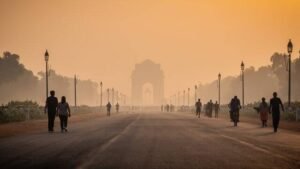Delhi Govt Enforces 50% Staff Rule to Tackle Pollution
|
General Studies Paper II: Government Policies & Interventions, Environmental Pollution & Degradation |
Why in News?
Recently, the Delhi government has enforced a strict 50% staff attendance rule across all government and private offices due to rising pollution levels in Delhi. Alongside this measure, the government has activated GRAP-3 restrictions to curb deteriorating air quality and protect public health.
Highlights of Delhi’s 50% Staff Attendance Rule
- Government Order: The Delhi Government introduced the 50% staff attendance rule as an emergency response to the rapidly worsening air quality in the National Capital Region. The order was issued by the Department of Environment after a review of pollution data from official monitoring sites.
- Administrative Authority: The environment department exercised its powers under Section 5 of the Environment (Protection) Act, 1986. This section authorises the government to issue directions during environmental emergencies. The rule is binding for all government offices and advisory for private establishments. The department made it clear that the rule is enforceable and that non-compliance can attract penalties under Section 15 and Section 16 of the same act.
- Operational Framework: Government departments and private organisations must now function with only 50% of their staff physically present on a working day. Senior officials such as departmental heads and secretaries are required to attend office regularly. Other employees will follow a rotation system. Offices that handle citizen services have been asked to prioritise essential tasks. Work from home will remain the default option for non-critical roles until pollution levels show a steady improvement.
- Accountability Measures: The government assigned district magistrates, police DCPs, and local bodies the responsibility of enforcing the attendance rule. These authorities must monitor offices and ensure compliance. They can issue warnings or initiate legal proceedings for violations.
- Exemptions: The order exempts certain sectors that cannot function remotely. The list includes health services, hospitals, fire services, water supply, sanitation, and public transport. These units must continue full operations.
Air Pollution Trends in Delhi
-
- Recent Data: Delhi faces severe air pollution every winter. Air quality worsened sharply in late November 2025. The city recorded a 24-hour average AQI of 382 on 24 November 2025. This level falls in the very poor to severe range. The pattern shows repeated spikes this season.
- Fifteen monitoring stations recorded values above AQI 400 on that day. Some pockets such as Wazirpur and parts of northern Delhi registered readings in the mid four hundreds.
- Fine particulate matter PM2.5 remains the main health concern. Real time platforms showed PM2.5 concentrations near 100 µg/m³ at many sites on the worst days. PM10 and ozone also contribute to poor air quality at different hours.
- Primary Sources: Vehicles emit a large share of fine particles and gases in Delhi. Diesel trucks and old cars release NO₂ and soot. Construction activity creates coarse dust. Industrial stacks add to local pollution. Local emissions mix with smoke from nearby states at times. Crop residue burning in adjoining states sometimes raises pollution but its share varies by year and wind.
- Recent Data: Delhi faces severe air pollution every winter. Air quality worsened sharply in late November 2025. The city recorded a 24-hour average AQI of 382 on 24 November 2025. This level falls in the very poor to severe range. The pattern shows repeated spikes this season.
- Seasonal Pattern: Winter months show the worst air quality. Cold nights form a temperature inversion, this inversion traps pollutants near the ground. Wind speeds also fall in November and December. Low wind and a stable atmosphere prevent dispersion. Historical data shows peaks from November to January each year.
Why it is Important to Control Pollution?
- Public health: Pollution control protects human health in every season. Medical data shows that PM2.5 exposure raises the risk of lung disease, heart attacks and asthma. The World Health Organization updated its air quality guidelines in 2021 stating that long term exposure to high particulate levels can reduce life expectancy. Delhi and many Indian cities record average PM2.5 levels that exceed these limits by several times during winter.
- Economic Productivity: A clean environment improves workforce productivity. Studies from national economic agencies show that bad air quality reduces working capacity and increases sick days. The Indian Council of Medical Research noted in recent assessments that pollution-linked illness affects workforce output in many urban centres. Pollution control indirectly supports sectors like tourism, retail and services. Cleaner air reduces public spending on emergency measures.
- Environment & Climate: Pollution damages the broader environment and affects natural cycles. High levels of nitrogen oxides, sulphur compounds and particulate matter harm soil quality and freshwater bodies. These pollutants also settle on leaves and reduce plant growth. Pollution also alters local climate patterns. Aerosols can trap heat over cities and increase urban heat island effects. These shifts influence rainfall patterns over time. Pollution control therefore protects ecosystems that support food production and biodiversity.
- Urban Governance: Cities manage pollution better when they build strong governance systems. Pollution control encourages governments to improve monitoring networks, transport systems and waste management practices. It pushes cities to adopt long term solutions such as green mobility, scientific waste disposal and cleaner construction practices.
What is GRAP-3?
- About: The Graded Response Action Plan (GRAP) is an emergency framework for the Delhi-NCR region. The plan assigns actions to air quality bands. Here Stage-III represents the “Severe” category. Authorities use Stage-III when the air quality reaches levels that pose immediate health risks. The Commission for Air Quality Management maintains and issues orders under the revised GRAP schedule.
- Criteria: Authorities invoke Stage-III when the average AQI falls within the 401–450 band or when forecasts and meteorology indicate worsening conditions. The decision uses official hourly and 24-hour data from the Central Pollution Control Board and other monitors.
- Measures: Stage-III imposes immediate curbs on major local emission sources. The measures include suspension of large construction and demolition work. The Stage restricts operation of stone crushers and mining in the NCR. Entry of older and polluting heavy vehicles into Delhi faces tighter limits. The Stage allows hybrid schooling and staggered office timings to reduce commute volumes. Diesel generator use and certain industrial operations face control in identified hotspots.
-
-
- The Commission revised the GRAP schedule in December 2024 and issued implementation orders through 2025. The revision moved some stricter controls to be enforceable earlier and to respond faster when air quality degrades sharply.
-
- Agencies Role: The CAQM, state pollution control boards, Delhi Pollution Control Committee, city administrations, and police share enforcement duties.
- The GRAP sub-committee issues action orders.
- District magistrates and traffic police implement on ground restrictions.
- Transport departments regulate vehicle entry and movement.
- Urban local bodies oversee construction bans and dust control.
|
AQI (Air Quality Index)
|
Way Forward
- Governments must set clear national and city targets for particulate reduction. The NCAP originally aimed for a 20–30% cut in particulate levels by 2024-25 over 2017-18. Cities must convert these targets into local action plans. Local plans must list sources and timelines.
- Policymakers must use WHO air quality guidelines as long term goals. Cities should adopt interim targets to move toward WHO levels. Health targets must drive policy choices in the transport industry and energy.
- Cities must shift people to public transport and electric vehicles. National schemes supported purchase of electric buses and two wheelers from 2019. Authorities must add charging infrastructure and fleet electrification targets. They must prioritise buses, trams and metro last mile links.
- Urban planners must enforce dust control on construction sites. Cities must invest in trees, parks and green corridors in high exposure zones. Research shows urban vegetation reduces local particulate concentrations and cools heat islands.
- Cities must widen the monitoring network and publish real time data. Forecasting must guide graded responses for this open data will help researchers and citizens.
|
Also Read: Delhi Air Quality in Very Poor Category |










